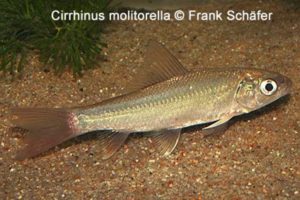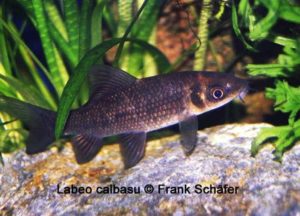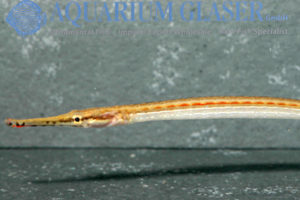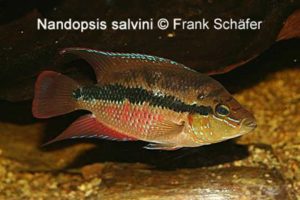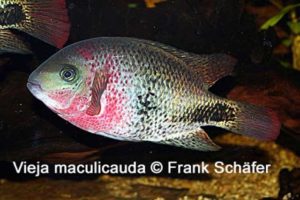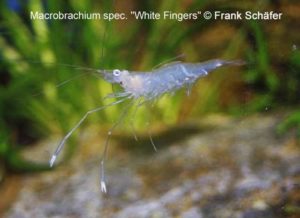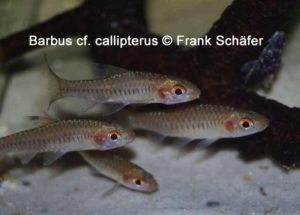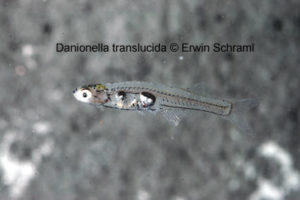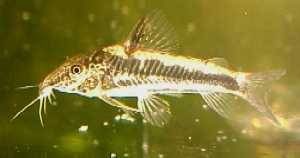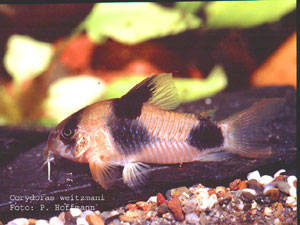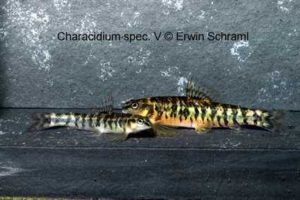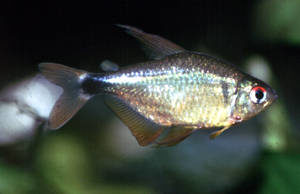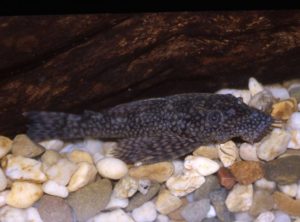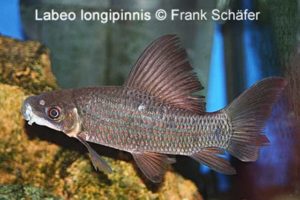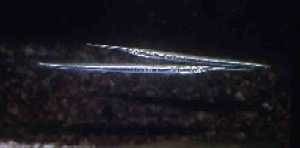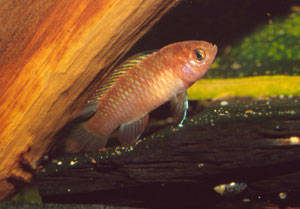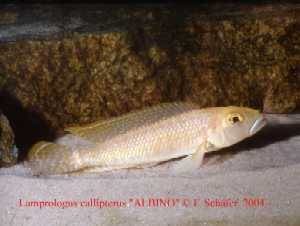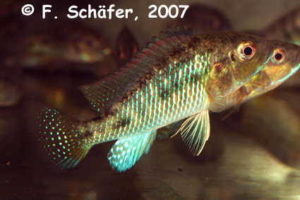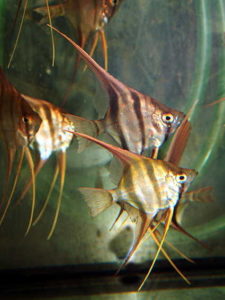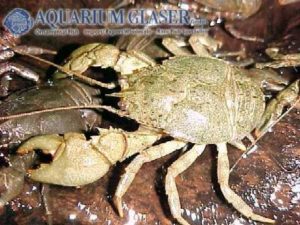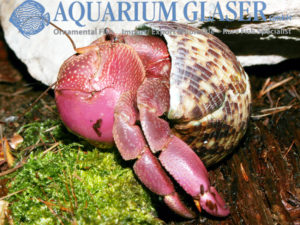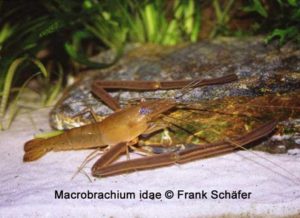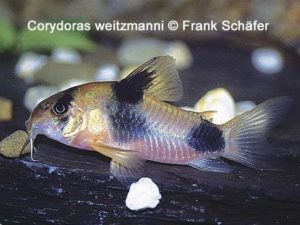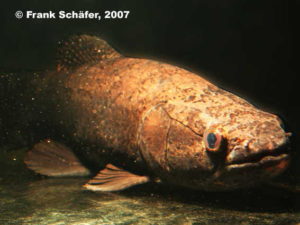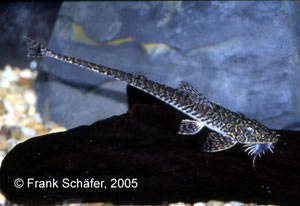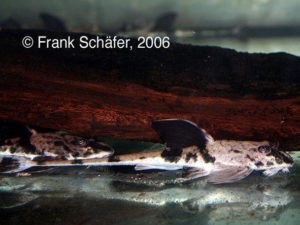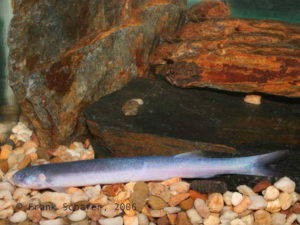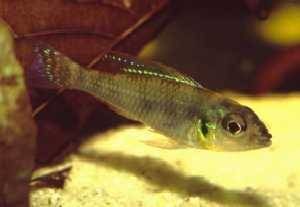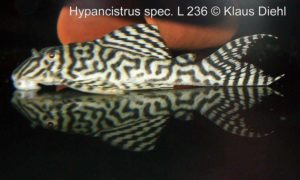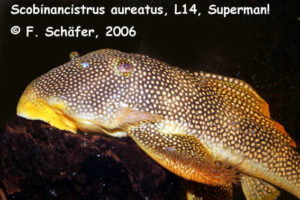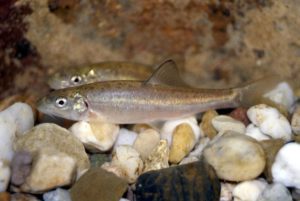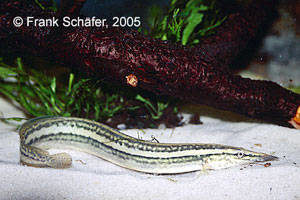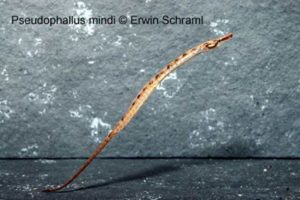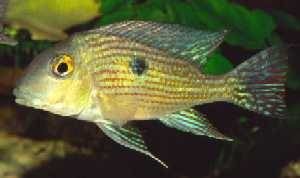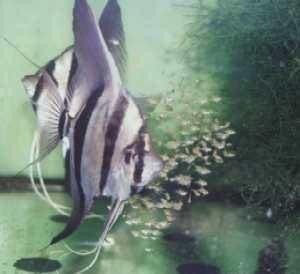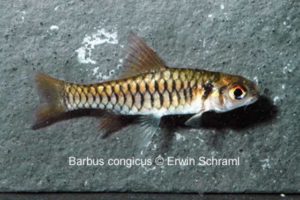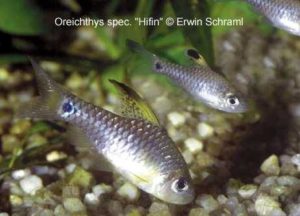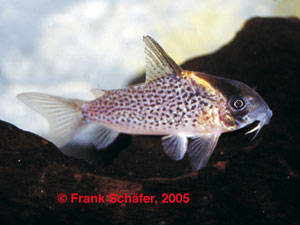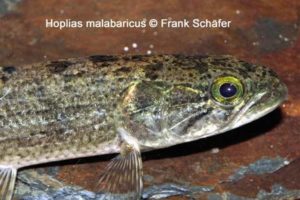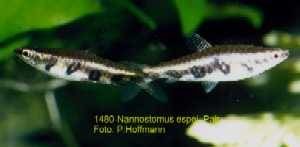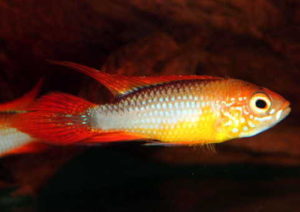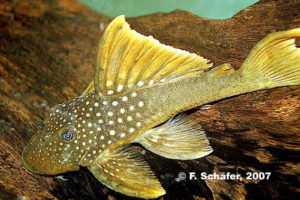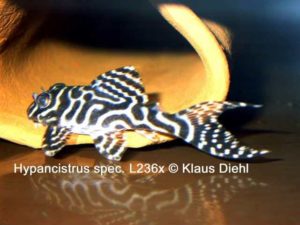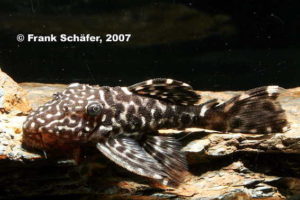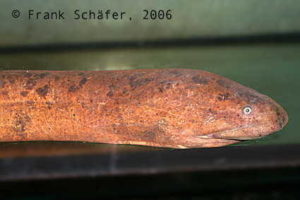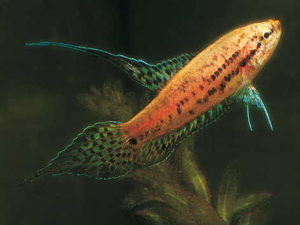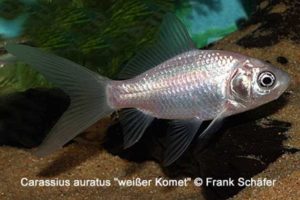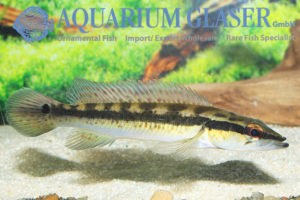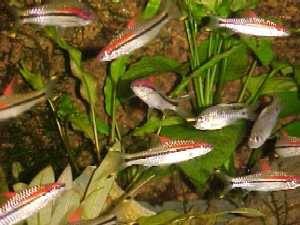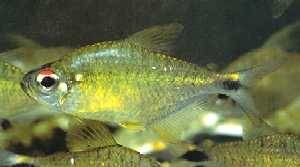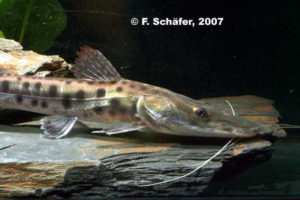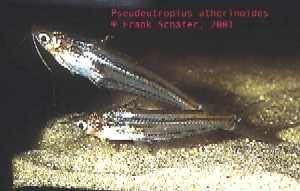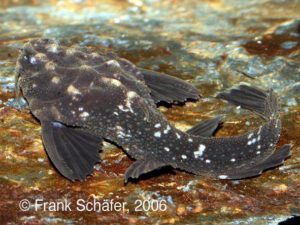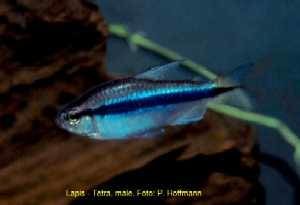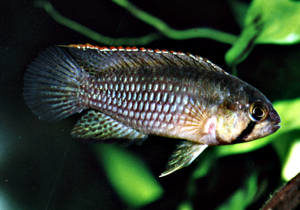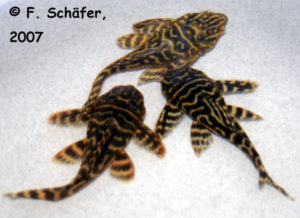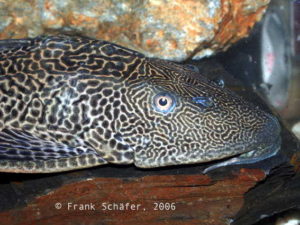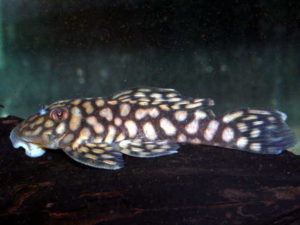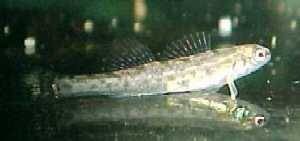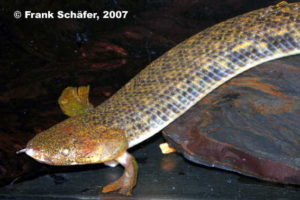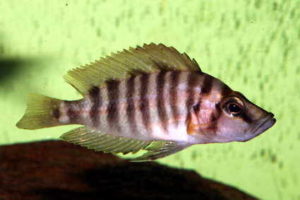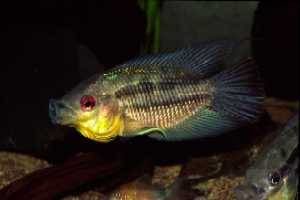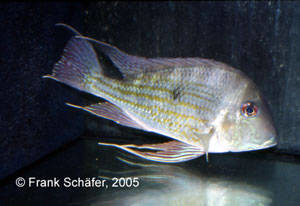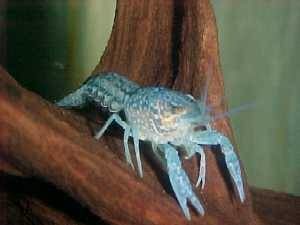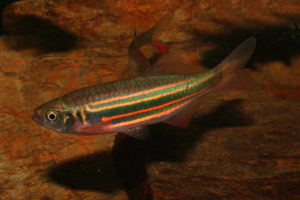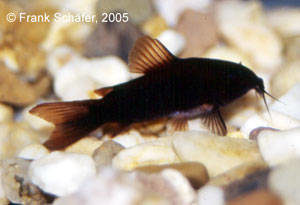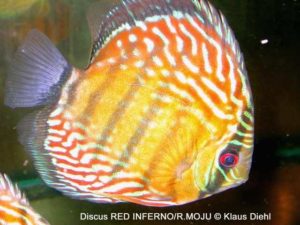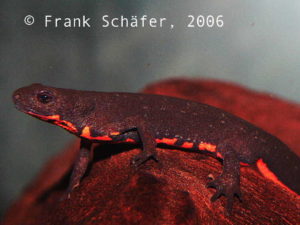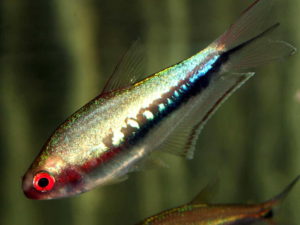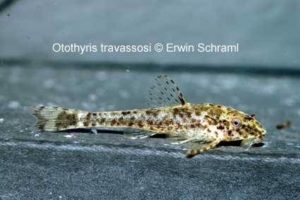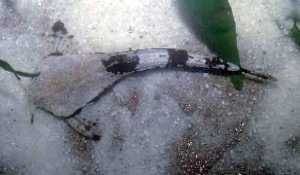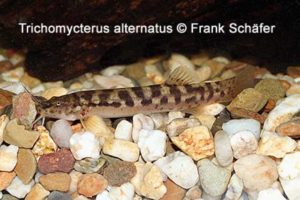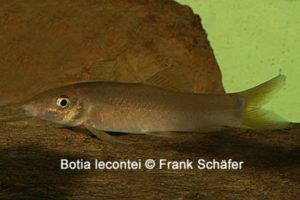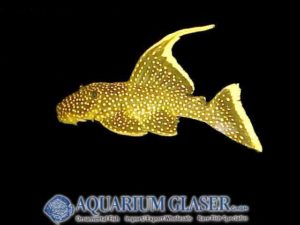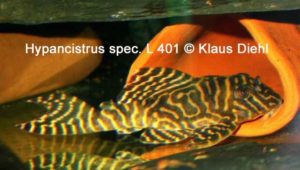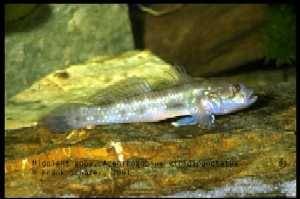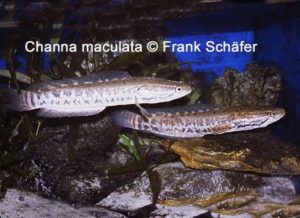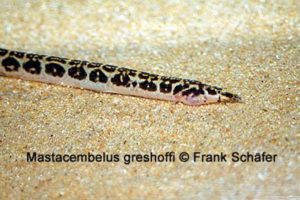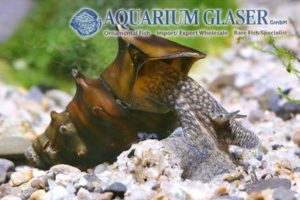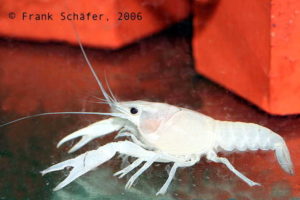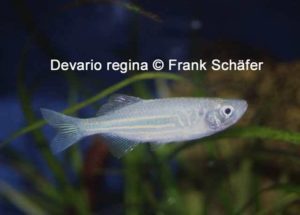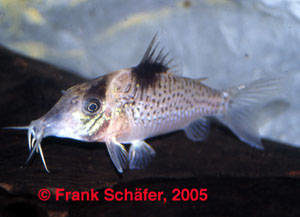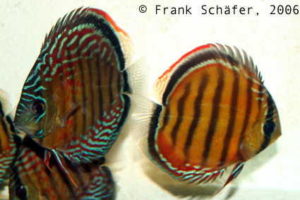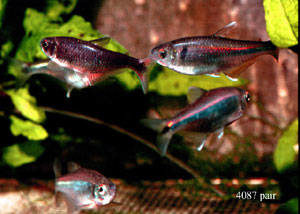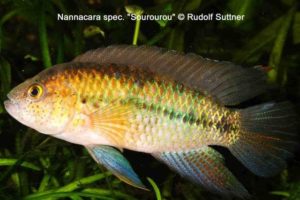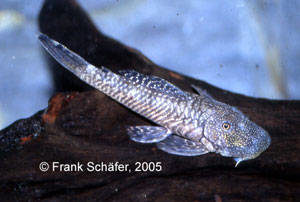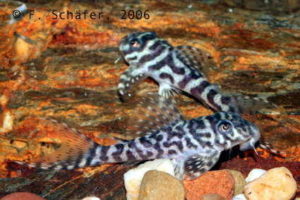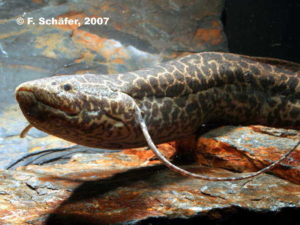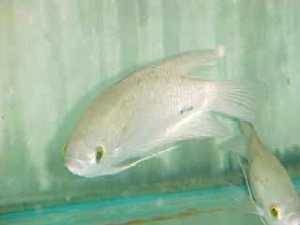If you are interested in a larger growing fish, the mud carp Cirrhinus molitorella originating from Southeast Asia, could be the right thing for you. In the list of fishing world records it is quoted with a length by 1 m and applies in Thailand under the name Pa Keng as a strong fighter at […]
Fish Archive (3137)
-
-
Labeo calbasu
Labeo calbasu the Orange-fin shark is a real king sized labeo. In its homeland (Pakistan, India, Bangladesh, Myanmar, Nepal, Thailand and South West China) it is a fish for consumption and therefore of importance in the asiatic aquaculture. With a size of up to 1m it is not a fish for the “normal” aquarium. Aficionados […]
-
Microphis lineatus
The species Microphis lineatus inhabits the (sub) tropical coastal waters of the American continent. This pelagic pipefish grows up to 22 cm lengths and has a very long slender snout with red spots and blotches. The body is brown or greenish above and pale below. There are very small white spots on the body and […]
-
Nandopsis salvini
December 2006: At present we can offer a very beautiful, strongly red coloured variant of Nandopsis (Cichlasoma) salvini to you. They origin from South Mexico, Belize and Guatemala, where they live in to the Atlantic ocean heading streams. Like most Central American cichlids they are very easy to keep in middle hard water at pH […]
-
Vieja maculicauda
Vieja (Cichlasoma) maculicauda the Blackbelt Cichlid is one of the larger Central American cichlids. Males can reach about 35 cm overall length. According to its size one needs voluminous aquaria, where their interesting social behaviour can be observed. In their distribution area (Atlantic slope, from the Usumacinta River drainage in Guatemala to the Chagres River […]
-
Palaemon concinnus
Over an enormous range, that includes nearly the entire Indo Pacific those first as Macrobrachium “White Fingers” designated Palaemon concinnus can be found. Their bright white “shear-fingers” are very remarkable and give this from Sri Lanka imported species a special attraction. It is about a rather delicate, smaller species, thus one could try to socialise […]
-
Barbus cf. callipterus
This strongly at Barbus callipterus reminding barb reached us from the tropical west Africa. Whether it is a variant of the Clipper barb B. callipterus or a near related species could yet not be clarified. The further information refers to the general maintenance conditions of bigger barb species.They are social swarm fish, which should be […]
-
Danionella translucida
Danionella translucida would have earned an entry in the Guiness book of world records. The largest measured individual was only 12mm long, thus acts it with this species around the smallest vertebrate anima. Apart from their extreme smallness the absence of sheds, as well as the high transparency of the dwarves are noticeable. They origin […]
-
Corydoras baianinha
March 2003: Some weeks ago we received a few pieces of Corydoras baianinha. This extreme rare Corydoras only occurs in a little number of small streams in the south of Brasil. The population of Cordoras baianinha is very much in danger, because its living space was already largely distroyed by environmental pollution and forest clearing! […]
-
Corydoras weitzmani
This is one of the most spectacular representative of the Corydoras genus recently imported. For us this is the ultimate Corydoras. Its closest relative is probably Corydoras panda. The body pattern is similar to the recently described Corydoras tukano. This species was caught by the authors in September 2004 in the riverine system of the […]
-
Characidium spec. V
This prettily drawn representative of the genus Characidium reached us over Rio de Janeiro, its actual occurrence area is unknown. A classification of the more than 50 Characidium species is difficult, for orientation we here adopt the numbering of the Aqualog photo collection. As natural biotope small clear watercourses are to be assumed. The water […]
-
Hyphessobrycon cf. loweae
It was illustrated on the homepage of Canadian fish exporter “Below Water” and designated as “Kitty” Tetra (“a new Hemigrammus-species, caught in Mato Grosso in November 2000). It is presented as Hyphessobrycon loweae in the February/March-issue of “Aquaristik Fachmagazin & Aquarium heute”. According to Dr. Géry there are “good correspondences” with Hyphessobrycon loweae (Costa & […]
-
Ancistrus spec. L 111
This ancistrus, which supposedly originates from Colombia, exhibits similarities to L 89, but like L 156 has round spots arranged in a honeycomb pattern. Unlike these other two L-numbers, L 111 has a uniformly marked iris ring and light/dark grey striped pectoral fin spines. This catfish is said to grow to about 10 cm, and […]
-
Labeo longipinnis
december 2005: For the first time in Europe we can present Labeo longipinnis from the Congo River to you. This about 30 cm long growing Labeo is not noticeable by a particularly spectacular design or colour. Due to its lively manner, beautiful form and fins it can become nevertheless a genuine “eye-catcher” in the community […]
-
Potamorrhaphis guianensis
These fish belonging to needlefish (Belonidae) reach the aquariums of interested hobbyists only very seldom. These robbers, called halfbeak, come from almost all over Amazonia. You can find them also in the Orinoco catchment area as well as in the Guyana countries. These specialized surface fish are only suitable for the the hobbyists with restrictions […]
-
Dario hysginon
Compared with Dario dario this species is hardly known by the general aquarists, although the males who obtain and guard their territory are looking very beautiful. Although they do not display the coloration like D. dario, they definitely show the same intense red colour. Unfortenately D. hysginon only shows his full colour when he is […]
-
Lamprologus callipterus ALBINO
August 2004: Now available: Lamprologus callipterus ALBINO. After several years, one of our breeder was successful in breeding this species. We have this fish for the first time in stock. You will find here more details soon.(Photo F. Schäfer, Text K. Diehl)
-
Pseudocrenilabrus philander
May 2007: From the Congo we received Pseudocrenilabrus philander. The fish originate from the upper parts of the Congo river (Lualaba). Their area of circulation covers nearly the entire southern Africa, where they are to be found in practically all types of waters. As mouthbreeders in the female gender their courtship and broodcare run after […]
-
Pterophyllum altum
The new season began, Pterophyllum altum (Orinoco) is available again. Deep Angels can reach 20cm length and up to 35cm in height. This has to be considered with the tank purchase, it should have a height of at least 70cm. A decoration with large bogwood, provides structure and retreat possibilities for them. Since they are […]
-
Aegla platensis
There are more than 60 species, all of them exclusively inhabitants of freshwater, in the genus Aegla, which belongs to the family Aeglidae. All Aegla species are inhabitants of southern South America. To date they have hardly ever been seen in the aquarium hobby. The specimens recently imported by Aquarium Glaser demonstrate, however, that Aegla […]
-
Coenobita brevimanus
The hermit crab C. brevimanus origins from coasts of the Indopacific, where it is found from the east coast of Africa to Tahiti. Coenobita brevimanus is the most terrestrial of all land hermit crabs. For the maintenance one needs a terrarium with only shallow water, because they do not like to get wet. Since they […]
-
Macrobrachium idae
January 2006: The long arm shrimp Macrobrachium idae reached us from Sri Lanka. Remarkable are their extreme long, name-giving “arms”, which can give the full grown animals an enormous broad reach. With that they are able to track small fish successfully, which naturally limits their use in the community tank. Together with larger fish species […]
-
Corydoras weitzmani
February 2006: We are pleased to be able to offer you the first offspring of a legend. Now offspring of the recently again discovered and in the last year for the first time to Germany imported Corydoras weitzmani are available. Fortunately this beautiful small, at Corydoras panda reminding species, could quite fast be spawned by […]
-
Hoplias macrophthalmus
With Hoplias macrophthalmus we could import from Colombia one of the biggest predatory fishes of the Amazon river system. Contrary to the regular imported Hoplias malabaricus these arrive only extreme rarely in the trade. As an adult with a weight of over 40 kg and a length of more than 120cm they belong to the […]
-
Crossoloricaria cf cephalaspis
The 5 species of the genus Crossoloricaria are all looking very similar to the flounder Loricariid genus Pseudohemiodon. These fish have as well a flattened body form, small eyes lying distally on the triangularly formed head. The difference between these two genii is the missing of the ventral bony plates of Crossoloricaria. Only at the […]
-
Loricaria simillima
Loricaria simillima has a very wide distribution in South America. It is found in the Orinoco-, Amazon- and La Plata basins. A result of this large area many different color forms are known, which differ clearly regarding coloration and pattern. The species occurs in different water types. Black water forms are more demanding in maintenance […]
-
Pareiodon cf. microps
This pencil catfish, a relative of parasitic the urethra of humans entering catfishes, is very rarely traded. The affiliation to the genus Pareiodon is rather clear, the species classification however is yet not clarifyed. As predators they should not be socialized with to small fishes. Due to their rarity no reports about their maintenance in […]
-
Biotoecus sp. „Tapajos – New“
For quite a while Aquarium Glaser imports this dwarfcichlid regularly from Rio Tapajos in Brasil. This Cichlids, which only get approx. 4-5cm can be kept in pairs in smaller aquariums from 50 ltr and up already. If the aquarium is bigger, a larger group can be brought in, but in doing so a slightly surplus […]
-
Ancistrus spec. L 352
Our photo shows a pair of Ancistrus spec. L 352, one with 6 – 7 cm very small remaining loricariid from the Rio Iriri. In the view from above the different body forms can easily be be recognized. This and the characteristic beard of the males makes a differentiating of the sexes quite easy. As […]
-
Hypancistrus spec. L 236
„Simply the Best “: Some days ago we could import some of this beauties. With a size of approx. 10cm the white of the here illustrated male shows a fantastic intensity. It seems that one of imported fishes is a not less beautiful female, and so we hope to be able to offer some days […]
-
Scobiancistrus aureatus L 14
December 2006: Last week received we a really impressive, male Scobiancistrus aureatus. With a length of about 30 cm it might be attained full growth. The strong spines on the gill cover (Interopercularodontodes), as well as on their pectoral fins are remarkable. As most L-catfishes from the Rio Xingu they like warmer waters, for their […]
-
Barbus barbus
This endemic species can be found through Europe, from France to the Memel River, in England in the Thames and a few other rivers and in the Danube and its tributaries. During the breeding season the male fish have a cloudy secrete on the head with white nodules. The females are considerable bigger and rounder […]
-
Macrognathus aral
This spiny eel originates from South East Asia, i.e. Pakistan, India, Sri Lanka, Bangladesh, Nepal up to Myanmar in their most southern distribution area. This fish is dawn and night active and will eat small fish. Therefore it should only be kept with larger tank fellows. In their natural habitat this species can reach a […]
-
Pseudophallus mindii
Pseudophallus mindii is a short snouted pipefish, which reached us as a by-catch in two exemplars. Their distribution contains central and tropical South America, where it is found predominantly in freshwater habitats. Adults were caught from estuaries and mangrove areas too, while planktonic juveniles have been collected well offshore at sea. As other pipefishes and […]
-
Geophagus sp. „Pindare“
Among the “Eartheaters”, species Geophagus, G. sp. “Pindare” is one of the most recommendable ones. Growing up to approx. 15cm only, it stays rather small and also shows a beautiful marking with red and blue lines on its flanks. The care of this species is really quite simple, because it does not care about the […]
-
Pterophyllum altum german bred
November 2003: Lately we received German bred Pterophllyum altum. It is worth mentioning that this was a natural brood, eg both parent took care for eggs and the young. Even spawning of the Altum Angel is a remarkeble event. This species tends to get panic attacks when the fish is fully grown. Thus they tend […]
-
Barbus congicus
The Congo Barb is a rarely traded ornamental fish. As you can see by their name Barbus congicus originates from the Congo river in Central Africa. With a length of 7 – 8 cm it belongs to the medium sized barbs and should, according to its vivaciousness, not be maintained in to small aquariums. With […]
-
Oreichthys crenuchoides (=spec. Hifin)
This barb out of the relationship of Oreichthys cosuatis measures about 5 cm. They originate from northern India. This species is characterised by a pronounced sexual-dimorphism, the males are more larger than females, only them show the magnificent, flag-like increased dorsal fin. The fish tank should be decorated with dense patches of plants on the […]
-
Corydoras sp. aff. kanei
This new and undescribed true mailed catfish differs from C. kanei by a golden band on the shoulder. The very attractive fish originate from the Rio Jamaxin (Brazil). Their final length is 5 cm. C. kanei has been bred successfully on several occasions and Seuß (Die faszinierende Welt der Corydoras, Landbuch Verlag Germany, 1997) reports […]
-
Hoplias malabaricus
“Here's lookin' at you, kid,” – but be careful. Otherwise it could happen that it will be the very last what a tank mate will be looking at. Under these beautiful green eyes are not less impressive teeth that makes the wolf fish Hoplias malabaricus a feared hunter. The owners of these from Costa Rica […]
-
Nannostomous espei
Up to now this ornamental tetra is only known from western Guyana/Southamerica in the lower course of Mazaruni River. Full-grown fish reach a total length of approx. 40mm. When putting on spawn the females are getting much plumper. By using their dish-shaped anal fin the males fix the eggs to a substrate (e.g. bottom of […]
-
Apistogramma agassizii „Fire Red“
September 2006: Few days ago we received a delivery of fishes from a well-known German breeder. The here introduced Apistogramma agassizi „Fire Red “increases the heartbeat of each Apistogramma fan. The strong red of the caudal -, dorsal – and anal fin forms a fantastic contrast with the blue-yellow body colouring and a dark longitudinal […]
-
Baryancistrus demantoides L 200 High Fin
From Colombia we could import expressed beautiful L 200 High Fin. Now we have very attractive partially completely yellow colored specimen of the species Baryancistrus demantoides in stock. They will get only about 15 cm long and remain thereby substantially smaller than the also with the number L the 200 labeled Hemiancistrus subviridis. Compared with […]
-
Hypancistrus spec. L 236x
November 2006: At Christmas we would like to present a star at the catfish heaven. We can offer some offspring of the queen imperial zebra Hypancistrus spec. L 236x, a beautiful and very looked for species. They come from a German breeder, who had the luck that the two from us imported animals formed a […]
-
Leporacanthicus sp. „NEW“
April 2007: We received a particularly beautiful easter surprise this week from Colombia. The representative of the genus Leporacanthicus illustrated here is probably the first and only specimen on the market. It reminds of the in the Orinoco occurring L 240 and L 241, as well as of Leporacanthicus cf. “Venezuela”. But its white spots […]
-
Synbranchus marmoratus
As a beauty in the conventional sense Synbranchus marmoratus can not be chracterised, but even the extraordinary has its attraction. At the moment we can offer beside swamp eels in „normal“ sizes a giant of approximately 1 m length. Of course a predator of this size should not be kept together with small „food fishes […]
-
Malpulutta kretseri
September 2006: As German breds we can offer Malpulutta kretseri. These preciousnesses are very rare in the wild and therefore strictly protected in their homeland (Sri Lanka). There they inhabit soft and sour waters and therefore their keeping in aquaria can be somewhat difficult. Small, dimly lit species tanks with a lot of shelters are […]
-
Carassius auratus „Weißer Komet“
At the first warm days of march humans get a certain urge to go outdoors. In the garden is exactly looked how everything becomes green and also the pond gets a first critical inspection and stocktaking. Who wants to supplement the fish population, can plan now and should include the white comet to its considerations. […]
-
Crenicichla spec. ITAPEMIRIM
We received this extremely colorful species of Crenicichla from the southeastern part of Brazil. In adults the sexes can be distinguished quite easily. Females (see main photo) have an ocellus in the dorsal fin which is missing in males (see additional photo). Moreover, in males the deep red spots are scattered over the body, whereas […]
-
Barbus denisonii
This splendid fish is endemicly (i.e. only there and nowhere else) found in several coastal rivers of South India. That is why only small quantities may be caught and exported as aquarium fish. You keep this fish best, which is used to flowing waters, in biggest tanks possible in a shoal. The feeding with frozen […]
-
Astyanax leopoldi
Because of their rhomboid body form these animals remind one a little of African tetras of the species Phenacogrammus or Bathyaethiops. Except from Rio Oyapock Astyanax leopoldi are also said to be found in Rio Approuague. They were named in honour of King Leopold III of Belgium, who attended an ichthyological expedition to Rio Oyapock […]
-
Pseudoplatystoma corruscans
The rarely traded largest shovelnose catfish Pseudoplatysoma corruscans originates from the Rio Sao Francisco in Brazil. This predator becomes quite large (approx. 180cm) and heavy (100 kg). They like to stay in groups and socialize well with rays, big charazins, cichlids or other catfishes. (Photo F. Schäfer, Text K. Diehl)
-
Pseudeutropius atherinoides
The „shark cats“ of the genus Pangasius are highly seeked for aquarium fishes, because their swimming behaviour reminds one on a shark. Sadly all species grow very fast and none of the species stays smaller than 50 cm, some even reach 150 cm or even more. For some time now so-called „mini-pangasius“ are introduced to […]
-
Amaralia hypsiura
January 2001: At present we can offer Amaralia hypsiura for friends of the extraordinary . This rarely dealt catfish attains full growth with approx. 15 cm length. It originates from the Amzon and there it feeds mainly, as gastric examinations of freshly caught fishes documents, predominantly the spawn of other fish. Fortunately they are not […]
-
Hyphessobrycon cyanotaenia, Lapis-Tetra
This tetra was introduced to us under the name of “Inpaichthys sp. Lapislazuli” in February 2002 by Mrs. Glaser-Dreyer (Aquarium Glaser GmbH). On the (Japanese) internet it is called Lapis tetra. It was imported in a bigger number of pieces without exact declaration of place of discovery. The males are growing up to at least […]
-
Nannacara sp. Essequibo
This fish was caught in October 2001 in a blackwater-river nearby Rockstone/Guyana. It is a peaceful fish which only grows up to 60mm. The males are more elongate than the females and have clearly visible spots in the dorsal and caudal fins. Water of following parameters was used for breeding and keeping them: 5°dGH, pH […]
-
Hypancistrus spec. L 340
Freshly arrived from Colombia: the Megaclown L 340. We can offer one of the most beautiful and at the same time most variable Hypancistrus “species” in very good quality. The animals already reached maturity, so that the outstanding contrast should remain. In their requirements for maintenance they do not differ from their Brazilian cousins, warm, […]
-
Liposarcus pardalis
Liposarcus pardalis has enormous area of origin that enclosure nearly the entire Amazon basin. It is found in different waters types, herefrom results a large adaptability for the maintenance in aquaria. According to the size (> 40cm) enormous food quantities are consumed. In Southeast Asia they are bred in large numbers and so wild caughts […]
-
Spectracanthicus (= Oligancistrus) zuanoni L 354
Spectracanthicus zuanoni L 354 originates from Rio Xingu and the Rio Iriri in Brazil. It has been described scientifically only in 2014 (see http://www.aquariumglaser.de/en/archiv.php?news_id=1195). The fish belongs to the same species as L 20, with however clearly larger white marks, so that the design reminds of a black net on a bright background. The reddish, […]
-
Etheostoma fusiforme
October 2003: This week we received a limited number of Etheosoma fusiforme. These goby-like perches are also called Darters and originates from North America. Darter males inspire during the courtship with beautiful colors. During the summer months this species can be held also in the domestic garden pond. (Photo F. Schäfer, Text K. Diehl)
-
Micropercops swinhonis
One of the most beautiful new fish species of 2003 is this goby, which is rather widely spread in China, Korea and Japan. Already in 1873 Günther described it under the name Eleotris swinhonis of Shanghai, China, but it made its way to our tanks only now. It can reach a maximum size of approx. […]
-
Polypterus teugelsi
From the Cross River system in Cameroon originates Polypterus teugelsi. This 2004 scientifically described species could be imported in this spring for the first time. They exhibit a black network, which covers an olive background on the dorsal and dorsolateral surface of the body. This and their brightly orange colored belly are singular in bichirs. […]
-
Altolamprologus compressiceps
From the shores of lake Tanganjika orgins (Alto)lamprologus compressiceps. There the about 13 cm long getting fishhunter inhabits the detrital zone, which it roams on search for food. When a prey is seen it approaches in slow motion, near the booty it speeds up and catches the victim. Because of its strong lateral flattening it […]
-
Chaetobranchopsis orbicularis
Chaetobranchopsis orbicularis is a plankton eater, which can reach a total length of up to 20cm. This may be one of the reasons, why it is not getting imported too often, as such nutrition specialists are mostly only interesting for specialists and enthusiasts. Yet the care of this species from Brasil is not neccessarily difficult, […]
-
Geophagus sp. „Tananaco“
This very beautiful representative of the surinamensis complex comes from Venezuela. These are very large animals of approximately 25 cm TL. The requirements of keeping, this species is not much different then the other members of its family. A sandy substrate, lots of shady hiding places like bogwood and round eroded stones, are basic requirements, […]
-
Procambaris sp. marbled blue
March 2002: This nice blue colour variant of the Marmorkrebs (the initially German name is now in international use and means „marbled crayfish“) is actually available. The Marmorkrebs is a remarkable species, because until now only females are known. The species breeds parthenogentically, eg females lay unfertilized eggs and produce only females again. As the […]
-
Devario assamensis
Some of the about 35 Devario species are found regularily in aquaria, others like Devario assamensis are rather rare. Therefore we are very happy to be able to offer you for the first time german bred Devario assamensis. Here it is about magnificent colored, circa 10 cm long getting barbs, whose origin is eastern India. […]
-
Corydoras sp. BLACK VENEZUELA
A very beautiful colour morph bred in Germany and a true addition to our fascinating hobby. Corydoras aeneus (this fish probably belong to this family) is one of the most common true mailed catfish in the aquaristical hobby. Originally this cory species has a large distribution in nature which ranges from Trinidad, Venezuela, Surinam, Colombia, […]
-
Discus „Red Inferno/Rio Moju“
Only one example of at present in extraordinarily good quality arriving Diskus is the “Red Inferno” variant coming from the Rio Moju. On their fins and flanks the animals show a strongly red-orange basic colour, which stands in beautiful contrast to the bluish green wave pattern. The icing on the cake are their cherry-red eyes, […]
-
Cynops orientalis
In its eastern chinese habitat the Chinese Fire Belly Newt Cynops orientalis inhabits small standing to slowly flowing overgrown waters. Females can get up to 10 cm long, the males remains with approximately 8 cm somewhat smaller. They can be kept predominantly aquatic, but a small land part with hiding places and climbing possibilities is […]
-
Nematobrycon lacortei
The Rainbow Tetra is one of the most attractive characins of South America. They origin from western Colombia, where they are caught in the tributaries of the Rio San Juan. They belong to the same genus as the usually better known Emperor Tetra Nematobrycon palmeri. Rainbow Tetras can not be characterized as true schooling fishes, […]
-
Otothyris travassosi
This rarely imported catfish species originates from the federal states Bahia and Espirito Santo at the coast of brazil. With only 3cm of total length it belongs to the smallest Loricariids. There habitats are small and fast running streams. They mostly stay in areas thickly covered with vegetation. Otothyris travassosi is not a fish for […]
-
Bunocephalus sp. „Black/White“
The banjocat new imported from Peru immediately attract attention due to their interesting colouring in contrast to other species of the same relation circle. Therefore some animals are almost unicoloured white while other specimens mainly show some irregular black markings. The care of this species does not differ from that of other relatives of this […]
-
Trichomycterus alternatus
One of the in the aquarium most easy to keep pencil catfishes is Trichomycterus alternatus. This species, originating from the Rio de Janeiro region, reaches an overall length of for 10cm and can be maintained in aquaria starting from 60cm length. These very shy fish, reminding in their appearance of our in Europe native Stone […]
-
Terranatos dolichopterus
May 2002: New arrival: german bred Terranatos dolichopterus, sailfin-killi (Aqualog “New World Killis, page 190 log-no: S27715). This fish comes from Venezuela, grows up to 5cm and should be kept in groups. The bottom of the tank should be peat, because they “dive” into the bottom when they spawn. (Photo F. Schäfer, Text K. Diehl)
-
Yasuhikotakia lecontei
From the watershed of the Mekong originates this circa 15 cm long getting loach. The name red finned loach is something misleading, since not all animals show this colouring in all stages of age. During their development they change colours and pattern. Young animals usually exhibit a pattern of stripes which disappears during ageing. In […]
-
Baryancistrus sp. L-81 HIGHFIN
September 2003: This week we received from Brasil a really unique fish: L-81 HIGHFIN. Our supplier advised us to send this fish and it really was worth waiting….was it not?(Photo F. Schäfer, Text K. Diehl)
-
Hypancistrus spec. L 401
This in the DATZ 12/05 introduced very beautiful Hypancistrus variant is at present in a small number available. The animals remind in their habitus of L 333 and with these are also occasionally confounded. In the figure they are more delicate, somewhat more stretched and reach only one overall length of maximally 12 cm, while […]
-
Acentrogobius viridipunctatus
This magnificent goby, it´s scientific name is Acentrogobius viridipunctatus, has now been successfully imported from India for the first time in greater numbers. The species attains a length of maximum 15 cm. Fully grown males have a very thick skull. In breeding mood, the fish become complete black in base colour, on which the emerald […]
-
Channa maculata
Channa maculata is a snakehead which origins of the border area of China and Viet Nam. It is there very common and offered on markets in large numbers, naturally as a food fish. In their habitat C. maculata lives in ponds, lakes and ditches, usually over sandy or muddy bottoms. With a final size of […]
-
Mastacembelus greshoffi
Some time ago we could import Mastacembelus greshoffi from the Congo. Here we have a spiny eel getting approximately 35 cm long, which occurs over rocky bottoms in rivers and lakes, also in rapids. Spiny eels are intelligent fish, they show a multiplicity of interesting behaviours. They also can become amazing tame and eat then […]
-
Brotia pagodula
(28.Nov.2007) From Southeast Asia we got a still rarely traded snail species. Brotia pagodula is a live-bearing snail, as an endemic species it can be found only in the Moei, a river between Myanmar and Thailand. Their strongly wound house, provided with numerous spikes, gives them a bizzare appearance. On the search for algae they […]
-
Procambarus clarkii „WHITE“
Under the numerous color forms of the Red Swamp Crayfish is Procambaris clarkii „White ” at present very popular. They are tough tank inhabitants, easily to reproduct and possess a high reproduction rate. Procambarus clarkii does not place large requirements towards the water chemistry, a strong filtering is however necessary, since they have a strong […]
-
Devario regina
The Queen Danio (Devario regina) is a tropical fish belonging to the minnow family (Cyprinidae). Originating in India, Myanmar, Thailand, northwestern Malaya, and the Mekong basin it is quite rarely seen in our tanks. Other species often found in the same locality as D. regina are Puntius lateristriga, Rasbora paviei, various Poropuntius, Neolissochilus, Barilius, Nemacheilus […]
-
Corydoras ephippifer
This true mailed catfish species was imported from Belem (Brazil). The latin name „ephippifer“ is a combination from „ephippium“ (lat. = saddle) und „ferre“ (lat. = bearing) referring to the black spot on the basis of the dorsal fin. The animals reach a maximal length of 6 cm. They should be kept in a group. […]
-
Diskus Nhamunda rosé
Nhamunda Rosé is the trade name of a strain of the brown discus Symphysodon aequifasciatus axelrodi originated in the Rio Nhamunda (northern influent of Amazon, west the city Alenquer). Now again some Nhamunda Rosé are available. Characteristic for this variety is the partially laminar high red part of the brown primary colour. Thus they are […]
-
New China Tetra
-
Ageneiosus vittatus
July 2002: For the first time we could import Ageneiosus vittatus from Peru. Slopehead catfish of the genus Ageneiosus are particularly noticeable by its strongly flattened head. These predators can reach an overall length of 30 cm. For the maintenance large basins are necessary. A dark bottom, some stones and bogwood should be brought in […]
-
Nannacara spec. -Sourourou-
From the Crique Sourourou in French Guyana originates this beautiful new Nannacara variant. We are pleased to be able to offer some offspring to you. According to information of an experienced Nannacara specialist their maintenance is unproblematic, even in middle hard water. The breed however succeeds only in soft and sour water according to their […]
-
Chaetostoma pearsei L 187
This Chaetostoma species is imported in regular intervals from the upper Orinoco through Puerto Ayacucho. This catfish is very difficult to differentiate from L 147 and L 188. L 188 has often described in the literature as C. nudirostre. C. pearsi lives in fast streaming mountain brooks and therefore needs in the aquarium oxygen rich […]
-
Hypancistrus spec. L 66 „King Tiger“
As one of the early imported representatives of the so-called L-number catfishes L 66 has already an unbroken popularity. At present we can offer beside wild caughts also very beautiful german breds. Such bright grounded L 66 are at least as attractive as the most „newer“ Hypancistrus species. With a final size of approx. 15 […]
-
Protopterus aethiopicus congicus
Freshly arrived: Marbled lungfishes (Protopterus aethiopicus) rank among the genuine survival artists. For respiration they are dependent on atmospheric air, if one refuses them the admission to the surface, they can drown in the water (aquarium). The air breathing allows them, however, a nearly amphibious way of life. So they are able to withstand desiccation […]
-
Osphromenus exodon
Even this fish looks like the common gourami, it is really something special & rare. As far as we know, this species was never before importet to Germany. When they have the size of about 30-40cm, they turn their lips inside out and show many small white teeths. Unfortunately this stadium is only shown in […]
-
Mastacembelus spec. „Kamerun“
This spiny eel reached us from Cameroon. The classification to a species was so far not possible for us. Since spiny eels predominantly are found on sandy to muddy bottom, they require a sand substrate in which to dig and hide. Flat rocks are also good for these fish to burrow under; just make sure […]
-
Chitala ornata, Clown Featherback
The Clown Featherback is well known to the hobby and has been imported as early as 1934 from South-East Asia. They are nocturnal fish and when they get older they become solitary. The fish tank should be decorated with dense patches of plants on the sides and back but should be kept with enough swimming […]
-
Ctenochromis polli
Ctenochromis polli occurring in the Congo River belongs to the rather rarely kept cichlids. Despite their body length of maximally 11cm they should not be kept in too small aquariums (100cm). The males are quite aggressive and pursue the females and suppressed males. They need sufficient hiding places, therefore the interior arrangement of the aquarium […]
-
Orthochromis stormsi
Orthochromis stormsi reached us as bycatch with Steatocranus casuarius. Both species originate from Central Africa, where they inhabit the cataracts of the Congo River. Their maximum size amounts to 12 cm, whereby the females remain somewhat smaller. The differences between sexes are only weakly pronounced, males appear more multicoloured, females have a darker basic colour. […]
-
Cichla temensis
Cichla temensis does not represent a fish for everyone. We could import them from Venezuela, where they are estimated fishes for consumption and sold under the name Tucunare. In its natural environment they can reach an overall length of 1 m with a weight of approximately 10 kg. They grow to be the largest of […]
-
Retroculus lapidifer
To take sensibly care of Retroculus lapidifer, which comes from Rio Tocantins/Rio Araguaia catchment area, you should own quariums with a base of 150 x 60cm minimum, as this species can grow very big (25-30cm). But despite its size you should not socialize it with aggressive cichlids, because it has only a certain self-assertion among […]
-
Cambarellus patzcuarensis
November 2003: New arrival! The orange dwarf lobster, Cambarellus patzcuarensis. They grow only up to 3-4cm. Just yesterday we got a very limited quantity from a german breeder. These dwarf lobsters are slightly agressive among each other. The origin is the lake Patzcuaro in Mexico.(Photo F. Schäfer, Text K. Diehl)





